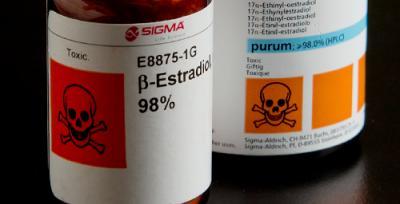2012 was the 40th anniversary since President Richard Nixon signed the Clean Water Act and established regulations for the discharge of pollutants to waterways - and even lets the government declare water itself as a pollutant.
Despite sewage treatment plants becoming more widespread, sewage can still be a major source for both naturally occurring hormones found in the environment and from both pharmaceuticals and personal care products (PPCPs).
Many rural communities in the United States use aerated lagoon systems, where oxygen-loving and anaerobic microorganisms remove many of the contaminants, to treat their wastewater. The water is then pumped into a series of other lagoons. Finally, the resulting water, known as the effluent, is discharged directly into a receiving stream.
The drugs, chemicals and hormone contaminants such as ibuprofen, caffeine and ethinyl estradiol from urban sewage treatment plants have been studied and monitored widely, but their occurrence in rural lagoon treatment systems is often overlooked.
In a new study, researchers determined the effectiveness of rural lagoon systems at removing these compounds from wastewater. The research was conducted jointly with the Illinois State Water Survey. Scientists collected water samples in September and November from a rural wastewater treatment plant located in a small town in Illinois. The facility treats sewage wastewater in two aerated lagoons, using a sand tank for filtration. The effluent streams into a creek that flows into the Mackinaw River. The researchers collected samples from various steps during the treatment process for analysis.

Researchers tested water samples from rural wastewater lagoons for the presence of 21 commonly used drugs, personal care products and hormones. Credit: L. Brian Stauffer
The researchers then tested the samples for the presence of 21 commonly used PPCPs and hormones, including caffeine and ibuprofen and found that the lagoon treatment system reduced concentrations of most of the tested compounds. The overall removal efficiency ranged from 88 to 100 percent in September, except for the compound carbamazepine, a drug used for the treatment of epilepsy and bipolar disorder that is notoriously difficult to remove from wastewater. There were no detectable steroid hormones in the aerated lagoons and effluent.
The samples collected in November contained higher concentrations of all detected PPCPs than the samples collected in September. According to Zheng, this is most likely because the microorganisms that break down the compounds work best in warm weather.
Although the efficiency of rural sewage treatment lagoons is relatively high, this study shows that there is a significant increase in the occurrence of PPCPs in surrounding watersheds with the effluent discharge, which could change the rural aquatic environment.
"Some compounds are easy to degrade and remove using this lagoon treatment system, but some compounds are persistent," said co-author Wei Zheng, a University of Illinois professor in the department of natural resources and environmental sciences. "When these persistent compounds are introduced into the environment through effluent discharge, they may contaminate water sources and affect the watershed ecosystem."
Because people eventually consume this water, the presence of PPCPs and steroid hormones is a concern.
"Pharmaceutical residues are usually detected in the aquatic environment at very low concentrations, below their therapeutic doses employed for medical purposes," he said. "However, long-term chronic exposure to these emerging contaminants in water supplies may jeopardize human and aquatic habitat health."
The research also is useful for addressing the potential risks of using rural sewage effluent for crop irrigation, especially as the occurrence of droughts increases. More research needs to be conducted to understand the environmental fate and negative effects of PPCP and hormone contaminants, but for now governments can properly utilize lagoon treatment systems to handle their wastewater and help state and federal agencies formulate prudent regulatory programs on agricultural irrigation of rural sewage effluents.
"The (federal Environmental Protection Agency) doesn't have regulations or management strategies for controlling PPCP and hormone contaminants released from sewage effluents, so our information can raise the public's attention, help the EPA develop the best management strategies and thereby minimize the loading of these emerging contaminants into the environment and promote the safe and beneficial reuse of treated wastewater in U.S. agriculture," Zheng said.






Comments